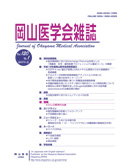

Journal of Okayama Medical Association
Published by Okayama Medical Association<Availability>
Full-text articles are available 3 years after publication.
Permalink : https://ousar.lib.okayama-u.ac.jp/14566
Exercise body surface maps in patients with left ventricular hypertrophy : Comparative study with stress thalliun scan (SPECT)
Hagihara, Hidenori
Published Date
1990-02
Abstract
For evaluating execise-induced myocardial ischemia in patients with ECG finding of left ventricular hypertrophy (LVH) with ST-T change, we recorded the body surface maps (QRST area maps) from 87 lead points before and after exercise and studied the patterns of the subtraction QRST area maps (S-maps) subtracting preexercise from postexercise maps in comparison with the findings of stress thallium (Tl) scans in 35 patients with hyertrophic cardiomyopathy (HCM) and 9 patients with essential hypertension (EH). All 21 patients whose S-maps revealed small changes less than -40μ VS or an increase only on the anterior chest region shoued no signigicant findings in the stress Tl scan. There were clear positive findings on the stress T1 scan in 7 of 8 patients with HCM (88%) whose S-maps revealed negative changes greater than -40μ VS on the wide precordial region and in 6 of 8 patients with HCM (75%) whose S-maps revealed increases on the anterior chest region but also had accompanying negative changes greater than -40μ VS somewhere on the precordial region. These results suggest that exercise QRST area maps may be useful in the identification of exercise-induced myocardial ischemia, especially in patients with HCM whose ECG showed LVH with ST-T changes. However, there were no significant findings on the stress T1 scan in 6 of 7 patients with EH whose S-maps revealed negative changes greater than -40μ VS on the precordial surfacre the same as those of HCM. These results suggest that factors other than exercise-induced myocardial ischemia such as the antonervous system may influence the ST-T cahanges in the EH cases. The specific mechanisms responsible for ischemic changes in patients with LVH (especialy in those with HCM) are not clear, although small vessel disease combined with myocardial hypertrophy or myocardial squeezing may be causative factors.
Keywords
体表面電位図
左室肥大
QRST isointegral map運動負荷(201)Tℓ心筋シンチグラム
ISSN
0030-1558
NCID
AN00032489
